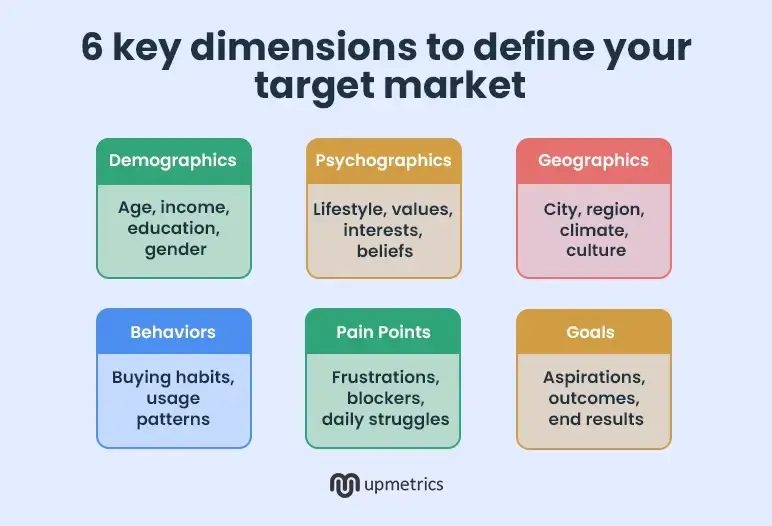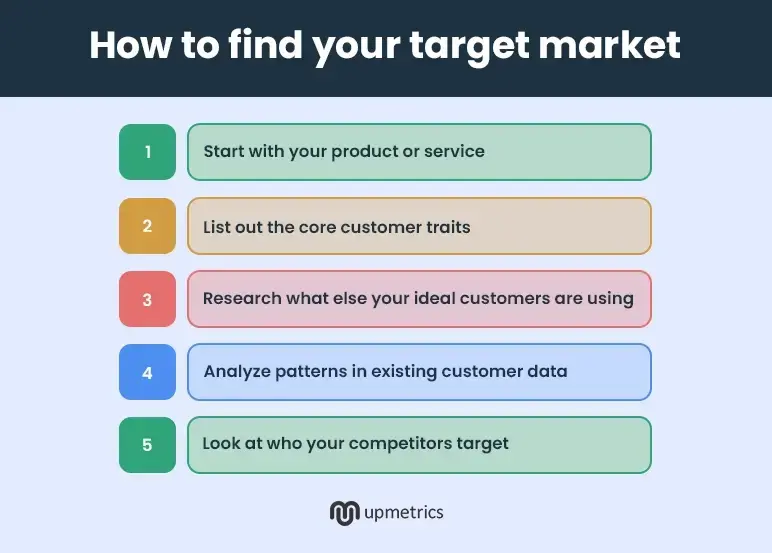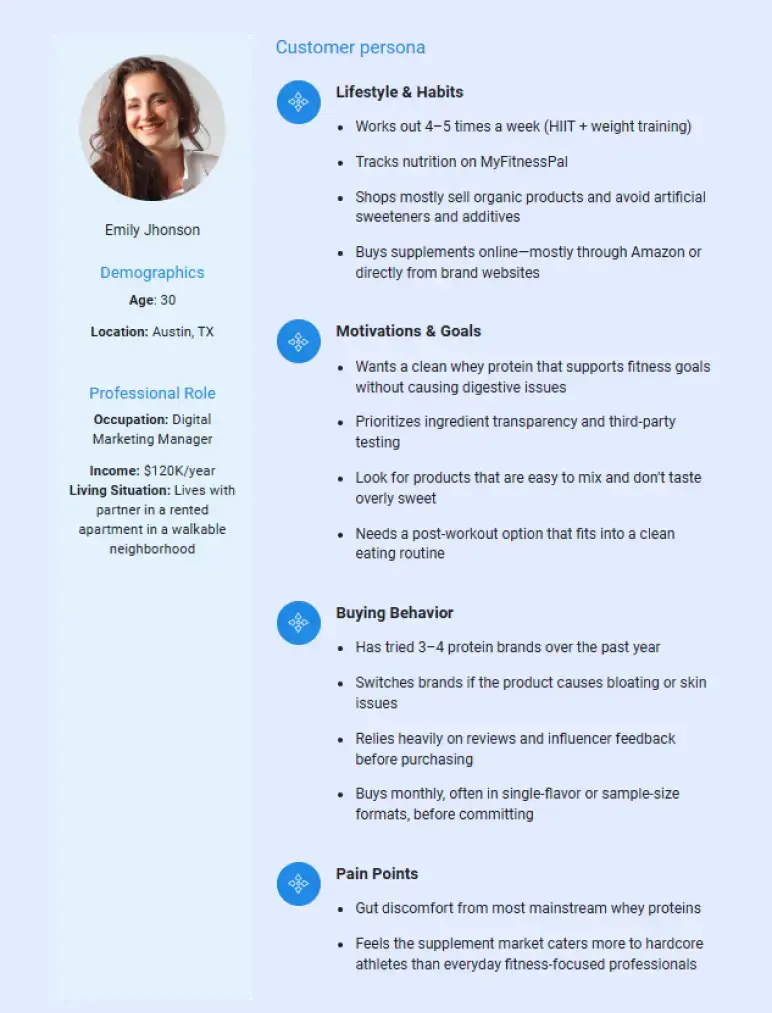If a product from a brand like Google (👀 read: Google Glass) can flop because it didn’t have a clearly defined market, it shows how critical targeting really is.
When most businesses fail, the issue often isn’t the product.
It’s unclear positioning, vague messaging, and not knowing exactly who they’re selling to.
Wondering how to find your target market?
Read along—you’ll learn what a target market is, the key components that define it, how to present it in a business plan, and what to do when your audience starts to shift.
What is a target market?
A target market is a specific group of people most likely to buy your product or service. These people share similar interests and characteristics and have common problems that your business can solve.
A clear understanding of your target market helps you build the right product, price it properly, and speak to the real needs of your potential customers. This understanding makes it easier to reach the right people with the right offer by guiding your product positioning and messaging.
Target market breakdown (six key dimensions)
Successful businesses aren’t the ones with the flashiest product or the biggest budget. They’re the ones who deeply understand who they’re selling to. These businesses know how their ideal customer thinks, what they care about, where they live, and what problems they want solved.
This kind of clarity comes from breaking your audience down across six simple, practical dimensions.

1. Demographics
Demographics covers basic details, i.e., age, gender, income, education, and occupation of your target market. These details are straightforward and data-driven, offering you a starting point for quantifying your market.
Despite being the most valuable information, only 42% of marketers have an understanding of their target audience demographics.
2. Psychographics
Psychographics dig into the mindset of your customer—their lifestyle, interests, values, and attitudes. When you understand this, you see what your customers care about and what drives their choices beyond basic numbers.
3. Geographics
Geographics define where your customers live. This includes analyzing their rural or urban setting, cultural influences, and seasonal patterns in their region.
The understanding of where your customer lives will help achieve a product-market fit and meet compliance requirements.
4. Behaviors
Behavioral traits uncover how customers interact with products like yours—how often they buy, what drives their decisions, and whether they see it as a need or a luxury.
This understanding helps you customize your marketing and communication approach for customers at different stages of their user journey.
5. Pain Points
This analysis taps into the frustrations and unmet needs of your customers. Understanding their pain points helps you shape a value proposition that feels relevant—because it speaks directly to what they’re trying to fix or avoid.
6. Goals
Goals reflect what your customers want to achieve using your product or service. Maybe they’re trying to save money, make faster decisions, or improve how they work. When you understand these outcomes, you can position your offer in a way that they actually care about.
How to find your target market (quick steps)
Identifying your target market might sound abstract, but it boils down to a series of practical steps. Here’s a straightforward process to discover who you should be targeting:

1) Start with your product or service
Start inward.
Analyze your products and services and list down the problems they try to solve. Next to the problem, list down the type of people who can benefit from the solution.
Dig a little deeper and find an answer to: What value does a person get by using my product or service?
Let’s say you are building a brand for clean protein. In this case, here are the problems you could be solving, the value proposition you could be delivering, and the potential customers you might be targeting.
| What problem are you solving? | What value are you providing? | Who is benefiting? |
|---|---|---|
|
|
|
Now, this step gives you a macro yet nuanced overview of the people you should be targeting. In this case, fitness enthusiasts who religiously take protein supplements are your core customer base.
However, if you dig deeper, the segment of customers with gut allergies, women in their thirties and forties, and teenagers are equally promising target audiences for your business.
2) List out the core customer traits
Now, visualize who your ideal customer is.
Jot down details about his demographics, psychographics, behavioral traits, and goals.
Ask questions like:
- How old are they?
- What’s their monthly income and spending style?
- Are they fitness enthusiasts?
- Where do they live?
- How much do they spend in your product category?
- What frustrates them about products in your category?
- What are they trying to achieve?
You don’t need data and stats to get precise here. Just use your best guesses and understanding of the market to bring together a buyer’s profile at this stage.
You will get a chance to validate these assumptions later.
Now, if you take that same protein brand, here’s how your ideal customer might seem:
“30-year-old working professional earning $120K a year, living independently or with a partner in a metro city. They’re serious about fitness, hit the gym five times a week, and regularly use protein supplements. They want a cleaner, gut-friendly protein option but aren’t ready to switch to plant-based protein.”
That’s just one group of customers.
A business can have multiple customer segments. The idea is to understand the size and scope of each segment so that you can prioritize better and craft messaging that speaks directly to each one.
3) Research what else your ideal customers are using
Step out and gather some concrete insights from market research.
Here, you would be using primary and secondary data to understand how your potential customers are meeting their needs right now.
Start with secondary research. Gather industry reports, consumer trend studies, and published surveys to get a broad overview of your customers and the market.
In the case of clean protein, you’d want to know:
- Who’s buying protein supplements?
- What protein types are growing in popularity?
- What concerns are shaping purchase decisions for consumers(like gut health, clean labels, or pricing sensitivity)?
Once you have certain clarity, go hands-on. Run short surveys, casual interviews, or even quick polls in gyms, health stores, and places where your potential customers hang out.
Ask users what they are currently using, why they chose a certain brand, and how satisfied they are.
This helps you see what’s working for them, what’s missing, and how strong their loyalty is.
At this stage, you may see many of your assumptions contradict the data. Spend some time digging through, talk to real people, put out products to test, and gather real market feedback.
4) Analyze patterns in existing customer data
Analyze the existing data to draw inferences. However, make sure that your marketing data is fully integrated, offering a single source of truth. (👀Only 27% of marketers from leading companies claim to have a fully integrated marketing data)
- Tap into your web analytics, CRM, and email lists to capture key traits like age, location, and browsing behavior of your customers
- Break down sales by product type, location, and order value. Are repeat purchases happening? Do certain products drive more add-ons or bundles?
- If you’re using email marketing, track which type of content gets clicks. Special coupon codes? Protein-packed recipes? Ingredient transparency? Those preferences will give you insight into the behavioral pattern of the consumer
- Read through support tickets, reviews, and feedback forms to understand what customers care about—or what’s frustrating them
If your customer base is significantly smaller, run targeted surveys to gather key data.
Even a handful of early adopters can provide direction. Perhaps you may find an unexpected group using your product. This could reveal a niche you hadn’t considered.
Let the numbers either confirm your hypothesized target market or prompt you to refine it. Real-world data will sharpen your aim.
5) Look at who your competitors target (and ignore)
Now study the market around you, i.e., your direct and indirect competitors.
Are there brands offering similar or at least the same base product as you? Also, are there brands indirectly competing against you? Think of brands selling protein-rich snack bars, ready-to-drink shakes, or even meal replacement smoothies.
Analyze these competitors by evaluating:
- Who are they marketing to?
- Who their target demographic is?
- What do their customer testimonials highlight?
- Are they using influencers or partnerships to signal a specific lifestyle?
- What pricing, tone, and positioning are they using?
Pay attention to patterns. If most brands in your space are clearly chasing high-performance gym-goers or premium wellness shoppers, that tells you something.
But go beyond, and observe the gaps. The market where they are lagging. Aspects where there is a clear demand but an unfulfilled gap.
For instance, the tone across all the brands might be overly masculine, leaving a potential and major demographic, i.e., kids and women, out.
Your diverse range of offerings can also target this audience, giving you a whole new range of customers to play with.
The stronger your competitive edge, the higher your chances of cutting through a crowded market and winning real attention.
These steps should give you a well-defined target customer profile (or a few profiles) that you can confidently aim your marketing and product development at.
How to define your target market in a business plan (W/ example)
The target market is one of the most important parts of your business plan. It typically appears in the market analysis or industry analysis, and it tells readers who you plan to serve and why that’s a promising market.
Here’s how to define your target market in a business plan:
- In a simple statement, clarify who your primary target market is, i.e., fitness enthusiasts looking for gut-friendly protein
- Demonstrate the business opportunity by highlighting the available market size for your business and backing that number with reliable reports
- In a line or two, explain the problem and pain point of your target customer, i.e., artificially laden and heavy on gut protein
- Establish alignment with your product and demonstrate why this market is a perfect fit for what you offer
- Build a buyer’s persona to offer a concrete overview of different market segments
Let’s now see what a buyer’s persona for a clean protein brand would look like:

How detailed should your target market be?
Detailed enough to help you build the right product and reach the rightful audience—but not so detailed that it restricts your reach or locks you into a narrow box.
Start with the pain point your product solves and who’s most likely to care. A product might serve a universal need, but if you can’t market globally, you’ll need to narrow it down—maybe by region, lifestyle, or habits.
For example, if you’re selling clean whey protein, you’re not targeting “fitness lovers” or “everyone who goes to the gym.”
You’re after people aged 25–40 with moderate to intense workout routines, who have gut sensitivity and actively avoid artificial ingredients. These are people frustrated by regular proteins that cause bloating or breakouts, and are willing to pay for something better.
Contrast that with a brand focused on kids’ nutrition. You want your message to reach parents of kids aged between 7-14 living in urban metropolises, looking for ways to increase protein intake for their kids.
That said, chase the details that help you shape your messaging, pricing, or product fit. If a detail is not adding any value, cut it down.
Be specific, but only when it’s relevant.
What to do when your target market changes?
Markets are constantly evolving.
Consumer preferences shift, new buyer groups emerge, and sometimes your product starts attracting a different audience than you originally planned for.
When that happens, the goal isn’t to resist the change—it’s to recognize it early and adjust with intent.
Here’s how you do that:
- Track customer behavior: Watch for shifts in who’s buying, how they’re using your product, and what they’re saying
- Reassess your market research: As and when the industry or market shifts, adjust your market segments and redefine the original personas to maintain relevance
- Adjust your messaging: Change in target market demands shift in audience—align the copies, visuals, and overall marketing strategy to meet the customers
- Make product adaptations: Introduce changes to your products and services by adding features or variations that may serve the new market better
- Clearly defined segments: Maintain a clear profile for each target market and prioritize your primary market to avoid stretching too thin
- Pivot if needed: Sometimes the target market would have a radical shift—in such cases, pivot
Crisply put, when your target market changes, pause, research, and realign till you find a product-market fit.
Need help figuring out your target market? And more?
Having a rough idea of who your customer is isn’t enough.
In a competitive business world, you need to know exactly where your customers scroll, what makes them hesitate before buying, what they expect from a brand like yours, and what they’re silently comparing you against.
Get that right, and everything else starts to click—your pricing, messaging, trust, and traction.
Now, while you figure out who your target market is, let Upmetrics help you present that insight clearly in your business plan.
Our detailed templates, built-in AI guidance, and structured planning tools make it easy to write a target market section that’s sharp, persuasive, and investor-ready.


